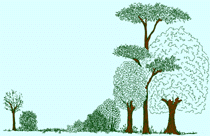|
PERMACULTURE DESIGN - a short introduction |
|
|
RESOURCE USE Identification of limiting factor The four capitals Building social capital
Health & equality |
The American writer Henry Thoreau grew tired of urban life in the mid-1800s and chose instead to live in woodland. He wrote in his journal: "I went to the woods because I wished to live deliberately, to front only the essential facts of life, and see if I could not learn what it had to teach, and not, when I came to die, discover that I had not lived". Over a century later, an Australian called Bill Mollison had a similar experience while working in the wildscape of Tasmania. He combined his observations of the natural world into an earth science in which he described self-sustaining systems. His period of living deliberately led him to believe that permanence, in the sense of enduring or everlasting, is a key element of sustainability, and so he named his earth science Permaculture. That name has come to have two meanings: permanent agriculture or permanent culture. The first expresses the will for a transformation in the way that we produce our food. At present, there is a reliance on solely annual cropping for food, in systems that have low ecological diversity. Permaculture looks to develop a more perennial planting system that has greater planned diversity, less ecological consequence, and do this by making better use of the benefits of natural systems. This meaning has sometimes given the impression that Permaculture is just about a system of sustainable food production. In reality, sustainability is only approached when all the things in our lives are designed to work well together and have minimal impact. Thus the second meaning, of a permanent culture, is probably a better explanation. It reflects that we should aspire to a rational state of being that has a mature and ethical behaviour at its heart. One example of this would be recognising the difference in outcome between optimising a system, whether in land use or social organisation, rather than maximising that system to get it to overproduce. Mollison soon found enthusiasts for his earth science. With an associate, David Holmgren, he was able in the late 1970’s to develop it into an applied design system. The protracted observation of natural systems on which it was based alerts us to one of the pitfalls of modern day life - that many of us have lost the ability to read and learn from what we see around us, whether it is a townscape or a rural landscape. This can isolate us from the consequences of everyday actions, and we may all too easily use up the wealth that people and the natural world provide. In a very real sense, this is a failure of vision that Permaculture aims to redress by giving us the tools to better define our reality. The challenge and the opportunity that Permaculture provides us with is to examine our lives to see where we may change our behaviour, to live more positively, and thus create a more sustainable existence. While this means giving greater value to natural resources, it also means giving greater value to our relationships with people. A society that is at ease with itself, which functions with few tensions, and which is based on justice and equality, is unlikely to be waging war or over-exploiting natural resources, but is hopefully enjoying peace in a land that has plenty. Mollison has described Permaculture Design as a system for creating sustainable human settlements. A designer, working for themselves or with a community, examines the working relationships between all the things in a location and produces thoughtful solutions that have more than one function and which are supported by many other elements – as is seen in nature. Effective design aims for energy efficiency, maximising diversity of elements, using and accelerating natural plant succession, increasing highly productive edge-zones within a system, and using waste as a resource for other processes. Permaculture Design is underpinned by an ethical framework, a developed system of design principles and tools, and a body of core knowledge that enables the designer to tackle many settings, whether urban or rural, people or place. Because so much of our understanding of Permaculture relies on seeing the whole picture, training in Permaculture Design follows the same pattern where learners are immersed in the comprehensive and concerted program of the 72-hour course rather than learning in a piecemeal fashion. The flowchart on the left shows what can be seen as some of the core subjects of Permaculture Design (follow the links to see notes for each topic). Additional topics introduced within a course relate either to the local conditions where the course is being delivered, or to the strengths of the leaders who have also learnt in this way so that the ethos and values of Permaculture are maintained. Mark Fisher - Permaculture Design course handout notes www.self-willed-land.org.uk mark.fisher@self-willed-land.org.uk |
